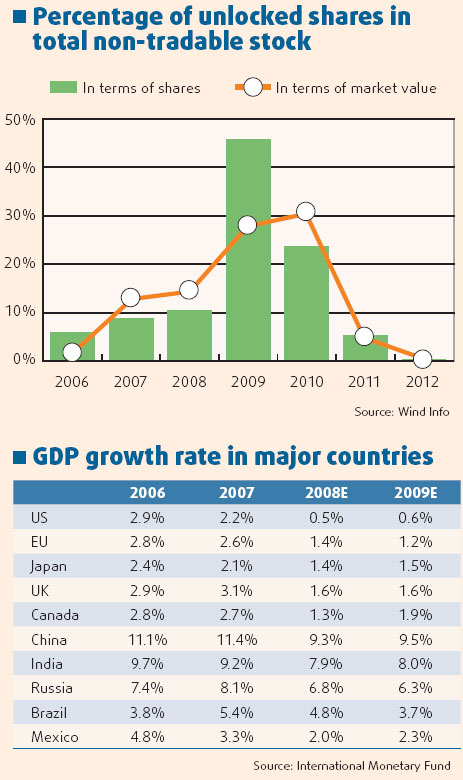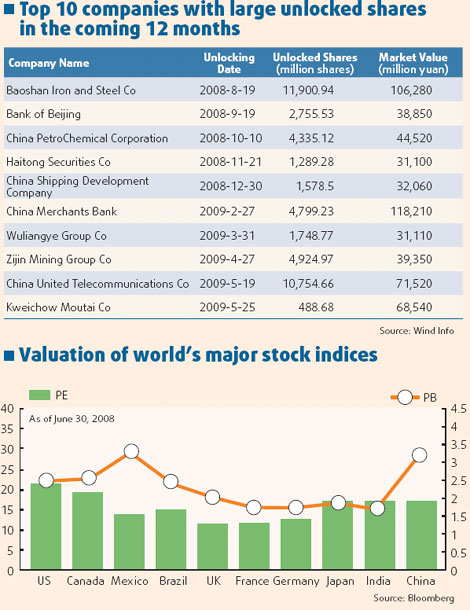
|
BIZCHINA> Center
 |
|
Related
Better stock performances expected in Q2
By Bi Xiaoning (China Daily)
Updated: 2008-07-14 17:22 Mainland stocks are down, but the second-half performance is likely to improve moderately, experts say. The shares' price-to-earnings (PE) ratio and price-to-book (PB) have dropped to a reasonable level, according to a recent report released by Goldman Sachs. This point of view could be found in many research reports released by brokerages. "The Hushen 300 index represents a PE of 20 times and PB of 3.4 times, with 35 percent premium when compared with the average stock index in the world's main market. Yet, in the mature markets, the GDP growth rate is below 3 percent," Dan Chaoyang, an analyst with Great Wall Securities Co, says in a report. "So, the premium is reasonable as China's GDP can grow at least 8 percent this year." India, China's counterpart, represents a PE of 16 times and PB of 4 times. Looking ahead, mainland stocks may drop further but the fall will probably be slight, according to the report. Industry analysts have reached a consensus that China's economy might continue to decelerate as a result of slower industrial output growth and weakening overseas demand. Yet, they believe China's GDP growth rate can reach 10 percent this year, as two main driving forces, fixed-assets investment and domestic consumption, are still strong. "As long as China's GDP growth rate can maintain some 10 percent this year, the listed companies' profits can be assured with increase of about 20 percent," Fareast Securities says in a research report. "Currently, many stocks are undervalued and long-term investment opportunities appear." According to the statistic, the industry companies have realized 1.1 trillion yuan in profits in the first five months, up 20.9 percent year-on-year. Shenyin Wanguo Securities and Citic Securities predict that the companies' performance in the last quarter will be better than the third. So far, about 20 brokerages have given a specific prediction on range of stock points in the second half. Pacific Securities is the most opportunistic, predicting the "bottom" will appear in July and then see the market rebound to some 4,500 points. Bohai Securities is the most cautious, predicting that 2,100 points is likely to be the market's bottom line. As of July 1, the Shanghai Composite Index plunged about 51 percent from the highest of 6,092 points last October, among Asia's worst-performing indices. Concerns are mounting over large-scale sales of non-tradable shares, slowing economies and hiking inflation. It's widely accepted that the expiry of the lock-up period for a large number of non-tradable shares smashed the investors' confidence and made the performance of mainland stock even worse than the United States and Vietnam. Looking ahead, the threat from large-scale sales of non-tradable stock is still problematic. "The current non-tradable stock is about 1, 225.65 shares and the unlocked climax exists in 2009 and 2010, with more than 60 percent of total non-tradable shares are to be changed to tradable ones," Essence Securities says in a report. In April, China's Securities regulators ordered shareholders to sell stocks on the block trading system if they expect to sell more than 1 percent of a listed firm's total shares within a month. Some major shareholders have also volunteered to hold the newly tradable shares. As of July 9, major shareholders in more than 20 companies have promised not to sell any newly tradable shares within two to three years. The assurance helps ease investors' worry. According to Wind Info, a provider of financial data, the nearest climax for unlocked shares is in August, with about 23.85 billion non-tradable shares to be changed. Amid this, about half of the shares are from Shanghai Baogang Group Company, China's largest steel maker, with 11.9 billion shares to become tradable . "Actually, it's also possible for the government to take further measures to rule the issue, because about 58.88 percent of non-tradable shares centralize in only about 10 larger-scale State-owned companies," Forest Securities says in a research note.

 (For more biz stories, please visit Industries)
|